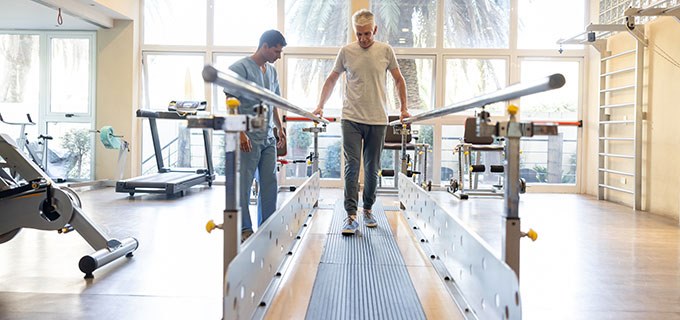Search for a doctor or hospital in your network.


Search for a doctor or hospital in your network.

Get News & Updates Directly To Your Inbox
Physical therapy is a type of care aimed at helping your body function and move better. It is also used to help relieve pain. It may be prescribed following an injury, after surgery or to help manage a chronic condition. Usually, the therapy is done in sessions of 30 to 60 minutes over several weeks or months.
Afterward, you’ll likely be able to do daily tasks much more easily and with less pain. More importantly, you’ll have learned new habits that will help you continue to improve your strength and movement.
If you’re injury or condition is non-urgent, see your regular doctor or primary care provider (PCP) first. Your doctor can decide the best course for your treatment. Depending on your issue, you may need surgery or be able to treat yourself at home. If neither of those options are best, your doctor may suggest physical therapy.
Once your doctor has referred you, your next step is a visit with your physical therapist. If you’ve had surgery, this may take place in a hospital. If not, you may go to a rehab center, therapy clinic or the therapist may come to your home.
During the first visit, your physical therapist will assess your needs through a series of questions and movement tests. They will ask you about your symptoms, pain level, medical history and ability to move. They will also check your balance and test your ability to walk, bend, reach or grasp or other movements based on your issue.
The goal is to work with you to create a care plan tailored to your body and the problems you want to address. When treatments begin, they will work to reduce your pain, restore or improve your function and help prevent disability.
Your therapist will likely use exercise in your care plan. This may include stretching, walking, lifting weights or resistance training. Your therapist will watch your movements to help ensure you move correctly. They may also give you exercises to do on your own.
These exercises may change over time and will likely become a part of your daily life. While you’ll start to feel better from your physical therapy during treatment, the main goal is to give you the tools to help you make those benefits last.
Another part of your therapy plan may include work to reduce swelling in your muscles and joints. This can entail massage therapy, ultrasound, heat, cold and other practices you can try on your own.
When your therapy sessions are done, your physical therapist will instruct you on using what you’ve learned in your daily routine. This may include stretches and exercises or steps for easing back into regular activity.
Be sure to follow the plan to get the most out of your physical therapy work. Sticking to your treatments can also help prevent further injury or pain. It may take you more or less time than others to reach your goals. Everyone is different. As with many things, physical therapy works through consistent practice.
Blue Cross and Blue Shield of Oklahoma, a Division of Health Care Service Corporation,
a Mutual Legal Reserve Company, an Independent Licensee of the Blue Cross and Blue Shield Association
© Copyright 2025 Health Care Service Corporation. All Rights Reserved.
Verint is an operating division of Verint Americas, Inc., an independent company that provides and hosts an online community platform for blogging and access to social media for Blue Cross and Blue Shield of Oklahoma.
![]() File is in portable document format (PDF). To view this file, you may need to install a PDF reader program. Most PDF readers are a free download. One option is Adobe® Reader® which has a built-in screen reader. Other Adobe accessibility tools and information can be downloaded at https://www.adobe.com/trust/accessibility.html.
File is in portable document format (PDF). To view this file, you may need to install a PDF reader program. Most PDF readers are a free download. One option is Adobe® Reader® which has a built-in screen reader. Other Adobe accessibility tools and information can be downloaded at https://www.adobe.com/trust/accessibility.html. ![]()
![]() You are leaving this website/app ("site"). This new site may be offered by a vendor or an independent third party. The site may also contain non-Medicare related information. Some sites may require you to agree to their terms of use and privacy policy.
You are leaving this website/app ("site"). This new site may be offered by a vendor or an independent third party. The site may also contain non-Medicare related information. Some sites may require you to agree to their terms of use and privacy policy.
Powered by Verint